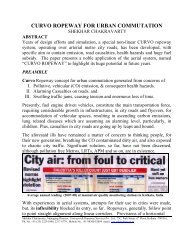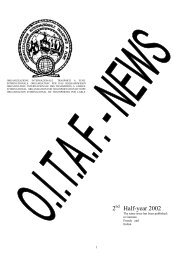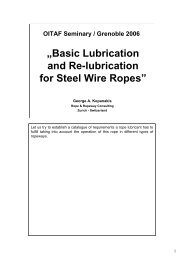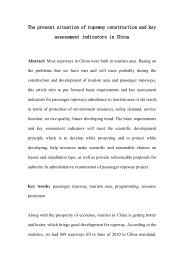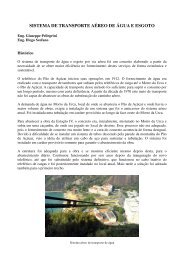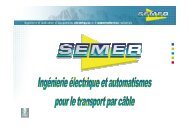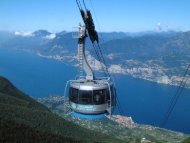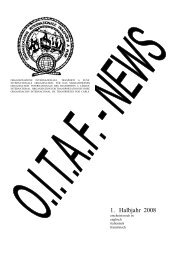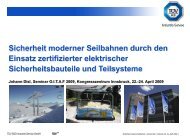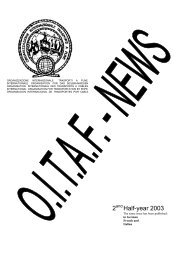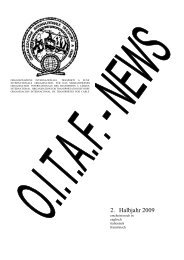urban gondolas, aerial ropeways and public transportation - OITAF
urban gondolas, aerial ropeways and public transportation - OITAF
urban gondolas, aerial ropeways and public transportation - OITAF
You also want an ePaper? Increase the reach of your titles
YUMPU automatically turns print PDFs into web optimized ePapers that Google loves.
4.10 INDUSTRY POSITIONING / RISKSToday two companies ─ Doppelmayr/Garaventa Group <strong>and</strong> Leitner Ropeways ─dominate the international ropeway market. This dominance is partly securedby existing intellectual property, technical capability <strong>and</strong> manufacturingcapacity. Therefore the authors believe that both are well placed to capture theUPT market.However this is no reason to be complacent. High-speed rail (HSR)manufacturers Siemens, Bombardier <strong>and</strong> Kawasaki recently discovered thatpatents <strong>and</strong> technical capability alone do not guarantee market security 1 (WallStreet Journal, 2010).While the existing ropeway manufacturers are favorably placed to serve the<strong>urban</strong> market, considerable investment <strong>and</strong> proactive strategies are required toensure this positioning translates into future success.4.11 SECTION SUMMARYInstalling <strong>urban</strong> <strong>gondolas</strong> as UPT is not a new idea. While the industry is sellingmore <strong>ropeways</strong> to the <strong>urban</strong> market than ever before success should bemeasured against the market opportunities that exist as opposed to moderateincreases in sales volume.Urban <strong>gondolas</strong> are competing with, <strong>and</strong> in some cases exceeding theperformance characteristics of traditional UPT technologies. However, cabletechnology is often excluded from transport analysis. Remediable steps could beundertaken by the industry <strong>and</strong> the market to ensure that ropeway technologiesare not ignored in the selection process of UPT technologies.The UPT market is significantly different from the TW market; thus newstrategies are required to better realize market opportunities.With increased <strong>urban</strong>ization comes the ever increasing dem<strong>and</strong> for viabletransport infrastructure. This creates favorable prospects for the UPT market<strong>and</strong> <strong>urban</strong> <strong>gondolas</strong>.The authors believe the UPT market will become the dominant market for thecable industry in the future as cities around the globe are beginning to realizethe potential for <strong>urban</strong> <strong>gondolas</strong> as part of a solution to their mobility needs.1 This point is discussed in a later section (Section 5.3).9
The industry is well placed to capitalize on future growth; however it couldbenefit from being more proactive <strong>and</strong> strategic in ensuring favorablepositioning that translates into future success in the UPT market.5 PAST MISTAKES AND FUTURE SOLUTIONSIn this section the authors discuss <strong>and</strong> demonstrate how three core issuescurrently hinder industry reception into the UPT market. Potential solutions areoffered to resolve each issue.5.1 MISTAKE 1: ALLOWING INACCURATE INFORMATION TO FLOURISH AND THE “URBANDISCONNECT”Unlike the TW market where decisions to install <strong>and</strong> purchase ski lift systems layalmost exclusively in the h<strong>and</strong>s of private sector decision-makers, <strong>public</strong>transport systems are typically procured by <strong>public</strong> sector transit agencies.Granted, the worldwide trend towards <strong>public</strong>-private partnerships (PPP’s) hasgiven the private sector more of a say in evaluating <strong>and</strong> consenting toinfrastructure projects, <strong>public</strong> sector officials still have the dominant role in anyUPT project.With this dominant role comes great responsibility. Public sector agencies,tasked with managing <strong>and</strong> administering capital works projects involving billionsof dollars of <strong>public</strong> monies, have a clear <strong>and</strong> demonstrable need fortransparency <strong>and</strong> accountability. Transport agencies must therefore be able toarticulate not merely what decisions they’re making, but why they’re makingthem.While there is no point suggesting that a given agency’s decision will always beclear, rational <strong>and</strong> independent of political interference, it is neverthelessimportant that these decisions be supported by as much independent ─ <strong>and</strong>ideally ─ peer-reviewed research as possible. In regards to <strong>urban</strong> <strong>gondolas</strong> thatresearch is entirely lacking ─ a situation causing the technology to be oftendisregarded as an option.This concept was highlighted explicitly in a 1988 O.I.T.A.F. Congress paper byBondada & Neumann in which they quantify the perceptions transport plannershave about a range of technologies ─ including <strong>aerial</strong> ropeway technologies.The findings indicate that the respondents’ views of cable technology werecharacterized by misperceptions concerning capacity, availability, headway,speed, costs, procurement <strong>and</strong> implementation.10
Bondada & Neumann discovered that “<strong>aerial</strong> cable gondola technology was theleast preferred” amongst respondents yet “planners <strong>and</strong> engineers with cableexperience ranked cable technologies higher in preference than individualswithout cable experience.” Compounding the problem, “the majority ofrespondents” had virtually no experience with the technology.In a follow-up to their 1988 study, Bondada & Neumann were quick to observethat for their study’s respondents “the major source of knowledge on all thetechnologies is ‘reading journals, magazines <strong>and</strong> other articles’ about thetechnologies” (1989). Unfortunately, journal <strong>and</strong> magazine profiles of cabletechnology were virtually non-existent at the time, a matter that has onlyrecently begun to change.The last comment notwithst<strong>and</strong>ing, in early 2010 one of this paper’s authors,Dale conducted a casual scan of 23 English language journals related to the fieldof <strong>urban</strong>ism <strong>and</strong> transport planning. That scan, while admittedly non-scientific<strong>and</strong> cursory, revealed only two mentions of cable technology over the past 20years ─ an inconsequential mention of tramways in a 1996 issue of the Journalof Public Transportation, <strong>and</strong> an article entitled ‘The Past, Present, <strong>and</strong> Future ofUrban Cable Propelled People Movers’, by Edward S. Neumann from a 1999issue of the Journal of Advanced Transportation.The need for more accurate <strong>and</strong> robust information applies not only to decisionmakers, but to the <strong>public</strong> <strong>and</strong> media that hold them accountable. Such accurate<strong>and</strong> robust information is still relatively non-existent.For example: In mid 2011, the CTV news agency in Canada reported on aproposed <strong>urban</strong> gondola system in Calgary, Alberta. Not a single image of a built<strong>and</strong> realized <strong>urban</strong> gondola system was shown. Instead, images of <strong>aerial</strong> tramtechnology, futuristic ‘concept’ systems <strong>and</strong> a wholly inaccurate artisticrendering of an ‘aerobus’ were used. In this case a prime marketing opportunityfor the industry <strong>and</strong> technology actually turned out to be both detrimental <strong>and</strong>counterproductive.Figure 5.1: THESE IMAGES WERE USED TO EXPLAIN WHAT AN ‘URBAN GONDOLA’ IS ON CTV PRIME-TIMENEWS. LEFT IS THE OLD ROOSEVELT ISLAND TRAM, CENTER IS A CONCEPTUAL DUAL-LOOP MONOCABLESYSTEM, RIGHT IS A 1960’S FUTURISTIC IMAGE OF AN ‘AEROBUS’. SOURCE: CALGARY CTV, 2011.11
What <strong>urban</strong> gondola research does exist is typically culled from compendiumsof O.I.T.A.F. congresses. While the papers within compendiums are typicallyaccurate <strong>and</strong> insightful, it is hard to argue that they are ‘independent’ sources ofinformation. This so-called ‘grey literature’ combined with manufacturers’marketing material dominates the conversation about <strong>urban</strong> <strong>gondolas</strong> <strong>and</strong>leaves questions about the validity of the claims made within the documents.The only other readily-accessible sources of independent research on <strong>urban</strong><strong>gondolas</strong> are government studies <strong>and</strong> analyses. Unfortunately, while thesesources may be considered independent, they tend not to be comprehensive oraccurate. The two highest profile examples of such documents are the ‘OgdenUrban Gondola/Tram Comparison’ <strong>and</strong> the ‘Hercules Aerial Tram Study’.5.1.1 OGDEN, UTAH URBAN GONDOLA/TRAM COMPARISONCreated by city council staff in Ogden, Utah in 2006, this document wasprepared “as a tool to help provide the Council with information about other<strong>gondolas</strong>/trams”. The purpose of the document was to compare <strong>and</strong> analyzeseven different <strong>urban</strong> gondola systems <strong>and</strong> was created after a ‘Transit CorridorStudy’ recommended the use of streetcars in Ogden rather than <strong>gondolas</strong>. Thereport is <strong>public</strong>ly available on the internet <strong>and</strong> ranks high in search engineresults.The sources for the report are poor; tabloid-style newspapers such as USAToday, Wikipedia.org <strong>and</strong> private sector brochures are the main sources ofresearch. No peer-reviewed or independently verifiable sources were used.At the time of the document’s writing, only three of the seven systems analyzedwere actually in operation. Of the others, the Portl<strong>and</strong> Aerial Tram was stillunder construction; the Mississippi Aerial Rapid Transit (M.A.R.T.) had beenclosed down <strong>and</strong> disassembled; <strong>and</strong> both the Baltimore Waterfront Tram <strong>and</strong>Philadelphia/Camden Skylink were mere concepts.5.1.2 HERCULES AERIAL TRAM STUDYConducted by Reconnecting America for the city of Hercules, California in 2007,the ‘Hercules Aerial Tram Study’ is comprehensive in that it accesses most of theavailable existing literature. Its analysis, however, is severely flawed due tothree critical errors made by the study’s authors:1. Study authors appear to confuse <strong>aerial</strong> tram <strong>and</strong> detachable gondolatechnologies. Even the title of the study is incorrect as the study itselfinvestigates detachable <strong>gondolas</strong>. Operating characteristics of the12
5.2 MISTAKE 2: OPPORTUNITY COST OF CHASING THE WRONG INSTALLATIONAs discussed previously, procurement in the UPT market is significantly morecomplex than in the TW market. This makes opening, qualifying <strong>and</strong> closingsales leads dem<strong>and</strong>ing <strong>and</strong> costly. Aggressively pursuing the ‘wrong’installations can be an expensive <strong>and</strong> risky endeavor as so many factors areinvolved in the <strong>urban</strong> sales process.Primary among these factors is the sheer number of stakeholders <strong>and</strong> decisionmakersinvolved in the UPT market combined with the length of the sales cycle─ conception to realization takes considerably more time within the <strong>urban</strong>market thereby increasing costs 2 . As the UPT market grows, manufacturersshould attempt to not waste resources on ‘dead end’ projects as promising <strong>and</strong>politically feasible projects could be neglected.With growth in the <strong>urban</strong> market coupled with the number of stakeholdersinvolved in any project, manufacturers should expect to field considerably morequeries for potential installations. To fully capture this growth in interest <strong>and</strong>translate it into success, the industry needs to be ‘smarter’ in qualifying <strong>and</strong>prioritizing its resources to installations that are most likely to succeed.In the past, chasing after the wrong <strong>urban</strong> installations has been wasteful <strong>and</strong>potentially damaging to the reputation of the manufacturers <strong>and</strong> technology.Notable North American cases of failed systems/proposals include:• M.A.R.T - New Orleans, United States• Ogden Urban Gondola - Ogden, United States• Harbor Gondola - Baltimore, United States• Montréal Telécabine - Montreal, Canada• Freedom Gondola - Detroit, United States <strong>and</strong> Windsor, Canada• Skylink - Camden / Philadelphia, United StatesM.A.R.T. was actually built, but ceased operations in as little as one year due tobankruptcy. When it was constructed, it was touted as the “transit system oftomorrow” (Lewiston Journal, 1984). Foundations for the Camden/PhiladelphiaSkylink, meanwhile, were also constructed but work stopped there. The othersystems never made it past the feasibility study level. What costs were incurredby the cable industry developing these projects?2 The Portl<strong>and</strong> Aerial Tram was originally imagined as far back as 1999 <strong>and</strong> would notactually open to the <strong>public</strong> until 2007 (although this only explains part of the extra costsincurred.)15
Due to language constraints, North American concepts/proposals aredisproportionately represented here but anecdotal evidence suggests suchfailed <strong>urban</strong> installations are not uncommon throughout the developed world.Maybe more worthy of contemplation are not the failed attempts to build <strong>urban</strong><strong>gondolas</strong> we know about, but the failed attempts to build <strong>urban</strong> <strong>gondolas</strong> wedon’t know about.The salespeople representing the manufacturers have clearly been a part of thecable industry’s successes within the TW market. However, one needs toquestion whether the techniques <strong>and</strong> tactics used in the TW market are suitablefor the UPT market.Common to all the failed proposals listed above (with the possible exception ofthe Ogden Gondola) is a specific focus on the tourism market in the <strong>urban</strong>environment. Yet despite repeated failures at tourist-oriented <strong>urban</strong> <strong>gondolas</strong> ina North American context, the proposals continue unabated.Very recent initiatives for <strong>gondolas</strong> in <strong>urban</strong> North America such as those in St.Louis, Ocean City, Atlantic City <strong>and</strong> Long Beach all share the same tourist-basedtheme <strong>and</strong> it is the authors’ opinion that all four are likely to suffer the samefate as those before them 3One must therefore ask if the existing sales model is too tourist-oriented to besufficiently effective for the <strong>urban</strong> <strong>public</strong> transit market.Underst<strong>and</strong>ing the fundamentals of any given <strong>urban</strong> environment will helpaddress these questions. This means appropriate education, proper duediligence <strong>and</strong> project vetting with the right advisers. These initial steps mayincur short term costs, but those costs are a fraction of actual <strong>and</strong> opportunitycosts incurred by chasing after installations that have little hope of ever beingrealized. Similarly, short-lived systems can end up damaging the reputation ofboth the technology <strong>and</strong> the manufacturers.5.2.1 POTENTIAL SOLUTIONSThe authors highlight the following solutions to resolve the issues associatedwith qualifying sales leads detailed in the previous section:• Use education <strong>and</strong> due diligence processes as a tool to identify <strong>and</strong>prioritize sound <strong>urban</strong> gondola opportunities while ignoring thoseunlikely to be realized.3The authors acknowledge that <strong>urban</strong> gondola systems tailored to the tourist market dohave a history of success outside of North America. The reason for this divergence ofexperience is not well-understood <strong>and</strong> would be worthy of further study.16
• Avoid being swayed by the potential opportunity any <strong>urban</strong> applicationrepresents. A significant portion of <strong>urban</strong> transit proposals are neveractually realized despite significant funds being committed to them.Learn to spot the strong proposals from the weak <strong>and</strong> dedicateresources appropriately.• Undertake a critical appraisal on whether the existing sales model issufficiently equipped for the UPT market or whether changes arerequired.• Consider educating salespeople in basic <strong>urban</strong> <strong>and</strong> <strong>public</strong> transitfundamentals <strong>and</strong>/or providing suitable advisers to assist salespeoplefrom the very beginning of prospective projects, <strong>and</strong>/or establishingspecialist UPT sales bodies.• Price <strong>urban</strong> installations accordingly to include the costs of duediligence <strong>and</strong> heightened market risk.5.3 MISTAKE 2: RESISTANCE TO CHANGE AND RISK OF COMPLACENCYIn 1995 Harvard Business School Professors Clayton Christensen <strong>and</strong> JosephBower developed the concept of ‘disruptive technologies’. The concept can besummarized easily from their Harvard Business Review paper ‘DisruptiveTechnologies: Catching the Wave’:“the processes <strong>and</strong> incentives that companies use to keep focused ontheir main customers work so well that they blind those companies toimportant new technologies in emerging markets. Many companieshave learned the hard way the perils of ignoring new technologies thatdo not initially meet the needs of mainstream customers.”Using example after example, Bower <strong>and</strong> Christensen make a compelling casethat, while it is important to listen closely to a company’s core customers (in thiscase the TW market), it is essential that companies not ignore potentialdisruptive innovations that have the ability to change entire industries (in thiscase the UPT market). It is the authors’ opinion that ropeway technology iscurrently acting as a ‘disruptive technology’ to the st<strong>and</strong>ard UPT market whilecontinuing to be a ‘sustaining technology’ 4 within the ropeway industry itself.4Bower <strong>and</strong> Christensen define ‘sustaining technologies’ as those that “tend to maintaina rate of improvements”; that is, they give customers something more or better in theattributes they already value.17
FIGURE 5.2: MARKET PERFORMANCE OVER TIME. SOURCE: THE NATIONAL ACADEMIC PRESS, 2011 FROMBOWER AND CHRISTENSEN, 1995.To date the industry has proven adept at sustainable technological innovation ─especially where profound environmental constraints have been present. Theinvention of the tricable configuration allows for massively increased spans withthe added benefits of increased capacity, speed <strong>and</strong> wind stability; heating <strong>and</strong>cooling systems were added to address temperature fluctuations; <strong>and</strong> safetyfeatures <strong>and</strong> processes have been developed to enhance passenger safety <strong>and</strong>allow for in-station rescues.In other words, the manufacturers have responded to external challenges withcontinual innovation. Yet most of these innovations have been what Bower &Christensen would describe as being of a sustainable variety. That is, they’veimproved gradually <strong>and</strong> sustainably in order to provide for the growing needs ofthe existing TW market.The UPT market has benefited too from these ‘sustaining innovations’, howevernot to the extent one might think. After all, systems like the MedellinMetrocable <strong>and</strong> Caracas Metrocable utilize st<strong>and</strong>ardized cable industrytechnologies with little innovation specific to the <strong>urban</strong> market.Unique problems still exist for <strong>ropeways</strong> within the UPT market <strong>and</strong> disruptiveinnovations specific to the <strong>urban</strong> environment are few. From an outsider’sperspective the industry appears to be cautious in undertaking innovations for18
this market. This concern is underst<strong>and</strong>able but does endanger all the positivedevelopments the industry has recently experienced in the UPT market.In the authors’ view, the following characteristics currently prevent thetechnology from growing rapidly within the UPT market:• Average line speeds are currently competitive with many st<strong>and</strong>ardforms of mass <strong>public</strong> transit in a variety of situations. Average linespeeds are not, however, competitive in long-distance alignmentslacking intermediate terminals.• Dwell times for <strong>urban</strong> <strong>gondolas</strong> are unacceptably long. Given the factthat high-capacity metro lines can operate with dwell times of less than20 seconds, there is no compelling argument for why an <strong>urban</strong> gondolamust operate with dwell times of 30-60 seconds.• Urban <strong>gondolas</strong> require greater design <strong>and</strong> architectural considerationsthan current best practices in transit planning allow for. Transplanting‘ski hill’ style <strong>gondolas</strong> into <strong>urban</strong> areas may not be ideal for manycities.• Similar to any <strong>public</strong> <strong>transportation</strong> mode, the option of includingheating <strong>and</strong> cooling equipment is a necessity though there still lacks aclear consensus on what the cable industry can <strong>and</strong> cannot do withheating <strong>and</strong> cooling systems for UPT systems.• Stations could benefit from a reduced footprint. Elevated of ‘slimprofile’ stations could fit more easily within existing transport corridorsreducing implementation costs <strong>and</strong> transport interference at the streetlevel.• Noise <strong>and</strong> privacy issues are likely to gain greater attention as thetechnology becomes increasingly noticed by those in the developedworld.Much of the UPT research <strong>and</strong> development to date has been directed towardsinnovations of ‘bottom supported’ systems such as Poma-Leitner’s MiniMetro<strong>and</strong> Doppelmayr’s Cable Liner technologies. Meanwhile, R&D for ‘topsupported’ detachable <strong>gondolas</strong> in the UPT market appears to have taken on alesser priority.Cable-drawn bottom supported systems have a number of benefits over theirself-propelled competitors in certain circumstances (Neumann, 1994) but theyhave yet to find mainstream acceptance as mass <strong>public</strong> transit. Today thesebottom-supported ropeway technologies appear designed to best mimic <strong>urban</strong><strong>public</strong> transit. Taking on such roles as airport people movers, the market haspositioned bottom supported technologies as a way into the <strong>urban</strong> market. Yet19
these systems are not proving as successful as <strong>urban</strong> <strong>gondolas</strong> <strong>and</strong> <strong>aerial</strong><strong>ropeways</strong> ─ technologies designed explicitly for non-<strong>public</strong> transit markets.Disruptive technologies tend to thrive in high growth markets where owners ofexisting technologies are slow to innovate ─ at least beyond the pace set bythose sustainable innovations dem<strong>and</strong>ed by a pre-existing customer base. Asthe UPT market grows for ropeway technology, executives would be wise torecognize that if the industry doesn’t innovate specifically for the UPT market,other companies will.5.3.1 THE CASE OF HIGH SPEED RAIL INNOVATIONHigh Speed Rail (HSR) lends us the perfect example.Chinese High Speed Rail manufacturers are now some of the most innovative onthe planet. After gaining a foothold in the Chinese market, foreign HSRmanufacturers were quickly out-paced by their Chinese counterparts. WhereHSR manufacturers traditionally focused on incremental innovation, todayChinese manufacturers are pursuing large-scale ‘disruptive innovations’.In as little as three years, Chinese engineers have taken inspiration from (somewould say ‘copy’) <strong>and</strong> dramatically improve upon existing HSR technologies(Wall Street Journal, 2010). Already Chinese HSR companies hold close to 1900patents for HSR technology (Xinhua News Agency, 2011). They operate trains ata significant speed premium over their competitors <strong>and</strong> only typically requirethe advanced electronics <strong>and</strong> signaling components from their Europeancompetitors (Wall Street Journal, 2010).Foreign competitors accuse the Chinese manufactures of ‘stealing’, but theChinese see it differently. China acknowledges that the trains its companies areselling were developed using foreign technology. The Railway Ministry stated“China’s railway industry produced this new generation of high-speed train setsby learning <strong>and</strong> systematically compiling <strong>and</strong> re-innovating foreign high-speedtrain technology”. One senior engineer was quoted as saying “we attained ourachievements in high-speed train technology by st<strong>and</strong>ing on the shoulders ofpast pioneers” (ibid).The lesson is simple: If a growing market is not being effectively saturated by anexisting technology or company, someone else will find a way to satisfy thatmarket need.20
5.3.2 POTENTIAL SOLUTIONSThe authors provide the following solutions to resolve the issues associated withsystem design <strong>and</strong> industry risks detailed in the previous sections:• Identify system characteristics that require innovation for the UPTmarket <strong>and</strong> invest in research <strong>and</strong> development in those core areas.• Do not assume, despite initial successes, that the performance-costpackage of a ski-lift style gondola will be appropriate for the UPTmarket.• Underst<strong>and</strong> that the needs <strong>and</strong> wants of the UPT <strong>and</strong> TW markets aredifferent. While the TW market still makes up the majority of ropewayindustry revenues, the needs of that market should not dictate theproducts offered to the UPT market. These are two dramaticallydifferent markets <strong>and</strong> should be treated accordingly.6 CONCLUSIONA number of strategies <strong>and</strong> tactics have been presented to help assist marketgrowth of <strong>ropeways</strong> in the UPT market. The previous sections 5.1, 5.2 <strong>and</strong> 5.3have highlighted what the authors believe to be the most significant barriersconstraining the industry’s growth into the UPT market. Recently, a body ofresearch has been accumulating that explains the merits of <strong>urban</strong> <strong>gondolas</strong> for<strong>urban</strong> <strong>public</strong> <strong>transportation</strong>. There is little doubt the technology has significantapplication potential within the UPT market. However, little research exists thatprovides a critical appraisal of the actual implementation from a marketing <strong>and</strong>design perspective, or that offers implementation strategies to better realizemarket opportunities.Optimizing the <strong>urban</strong> market requires a two-pronged strategy:• Tailoring communication <strong>and</strong> marketing to UPT <strong>and</strong>• Tailoring system design to UPT.Of utmost importance is the need to address the underlying structure that takesthe product to the market ─ that being accurate <strong>and</strong> effective communicationof research to appropriate decision-makers <strong>and</strong> their staffs. This core structureis woefully lacking <strong>and</strong> currently counterproductive to realizing marketopportunities ─ the “<strong>urban</strong> disconnect”. The industry offers a competitive UPTtechnology, but unless the benefits are properly communicated to the endconsumers, market opportunities will not be fully realized.Along with addressing the “<strong>urban</strong> disconnect” issue, technology <strong>and</strong> systemdesign components require attention. The industry should be commended for21
esponding to technological limitations with innovations in the TW market.However, it is important for the industry not to ignore the needs of the rapidlygrowing <strong>urban</strong> <strong>public</strong> <strong>transportation</strong> market.For the ropeway industry, UPT is the future.7 ACKNOWLEDGEMENTSThe authors would like to thank Julia Padvoiskis for her valuable assistancereviewing <strong>and</strong> editing this paper.8 REFERENCESAlshalalfah & Shalaby, 2010. “Aerial Ropeway Transit: State of the ART”.Sourced on the 2nd of July, 2011 fromhttp://amonline.trb.org/12kjar/12kjar/1Bondada & Neumann, 1988. O.I.T.A.F. Congress Paper – “Aerial Cable Transit –Where does it fit into the <strong>urban</strong> mobility picture?”.Bondada & Neumann, 1989. “Automated People Movers II: New Links For L<strong>and</strong>Use Automated Mover Opportunities For Major Activity Centers”.Published by the American Society of EngineersChristensen & Bower, 1995. “Disruptive Technologies: Catching the Wave”.Creative Urban Projects, 2010. Urban research on the South America market.CTV Calgary, 2011. News Media - “Urban Gondola transit of the future”. Sourcedon the 15th July, 2011 fromhttp://calgary.ctv.ca/servlet/an/local/CTVNews/20110503/CGY_gondola_cable_110503/20110503/?hub=CalgaryHomeDale, 2008. “re-introducing air-Trams”.Dale, 2010. Image from “The Gondola Project: Medellin/Caracus, Part 3”.Sourced on the 15th of July, 2011 fromhttp://gondolaproject.com/2010/03/14/medellincaracas-part-3/Fletcher, 2005. O.I.T.A.F. Congress Paper – “Future Perspectives of Ropeways inNorth America”.Graph <strong>and</strong> Text. United Nations / Department of Economic <strong>and</strong> Social Affairs /Population Division, 2005. “World Population Prospects: The 2005Revision”. Retrieved on the 5th July, 2010 fromhttp://www.un.org/esa/population/<strong>public</strong>ations/WUP2005/2005wup.htmHoffman, 2006. “Recent Developments in Cable-Drawn Urban TransportSystems”. FME Transactions (2006), 215-212.22
Hoffmann & Liehl, 2005. “Cable-drawn <strong>urban</strong> transport systems” in WITTransactions on The Built Environment, Vol 77, 2005 WIT PressHoffmann, 2006. “Recent Developments in Cable-Drawn Urban TransportSystems” in FME Transactions (2006) 34, 205-212Lewiston Journal, 1984. “New Orleans: Wonderl<strong>and</strong> on the river”. Article datedApril 27, 1984.McLennan, 1988. O.I.T.A.F. Congress Paper – “Recent Innovations in GondolaLifts <strong>and</strong> DMC Lifts”.Neumann, 1992. “Cable Propelled People Movers in Urban Environments”. InTransportation Research Record: Journal of Transportation ResearchBoard, No 1349, TRB, National Research Council, Wellington, D.C, pp125-132Neumann, 1994. O.I.T.A.F. Congress Paper – “Cable Systems for Urban ActivityCentres: Is Progress Being Made?”.Neumann, 1998. O.I.T.A.F. Congress Paper - “Cable Propelled Systems in UrbanEnvironments”.Neumann, 1999. “The Past, Present, <strong>and</strong> Future of Urban Cable-Propelled PeopleMovers”. Journal of Advanced Transportation 31, 51-82.Ogden City Council, 2006. “Urban Gondola/Tram Comparison”. Sourced on the28th of July, 2011 from wcfgoldmine.com/gondolacomp.pdfReconnecting America, 2007. “Hercules Aerial Tram, Mobility Study <strong>and</strong> Report”.Sourced on the 2nd of July, 2011 fromhttp://ctod.org/portal/node/2185The National Academic Press, 2011. From Christensen & Bower, 1995. “FIGURE6.1 Performance characteristics of a disruptive technology”. Sourced onthe 28th of July, 2011 fromhttp://www.nap.edu/openbook.php?record_id=12619&page=243The Wall Street Journal, 2010. “Asia Technology: Train Makers Rail AgainstChina’s High-Speed Designs”. Published on the 17/11/10. Retrieved onthe 5th of July, 2010, fromhttp://online.wsj.com/article/SB10001424052748704814204575507353221141616.html?mod=googlenews_wsjTongji University, 2008. “Mobility for Development”. Sourced on the 30th ofJuly, 2011 fromhttp://www.wbcsd.org/Plugins/DocSearch/details.asp?DocTypeId=24&ObjectId=Mjk3ODkTupper, 2009. “Burnaby Mountain Gondola Transit Feasibility Study”.23
United Nations: Department of Economic <strong>and</strong> Social Affairs: Population Division(United Nations), 2010. “World Urbanization Prospects: The 2009Revision: Highlights”. Sourced on the 15th of July, 2011 fromesa.un.org/unpd/wup/Documents/WUP2009_Highlights_Final.pdfXinhua News Agency, 2011. “China's high-speed rail technologies better thanJapanese Shinkansen”. Soured on the 19th of July, 2011 fromhttp://news.xinhuanet.com/english2010/china/2011-07/07/c_13972135.htm24
9 APPENDIXYearTABLE 9.1 - SYSTEM DIRECTORYUPTorientedTouristorientedTOTAL InstallationsName & Location1974 X 1 Sentosa Isl<strong>and</strong> Cable Car, Sentosa Isl<strong>and</strong> (Singapore)1976 X 1 Roosevelt Isl<strong>and</strong> Tram, New York City (United States)1984 X 1 MART, New Orleans (United States) – now closed1998 X 1 Teleferico Parques de Nacoes, Lisbon (Portugal)1999 X 1 Monte Cable Car, Funchal (Portugal)2004 X 1 Metrocable 'Linea K', Medellin (Columbia)2006 X 1 Ngong Ping 360, Hong Kong (China)2007 X 1 Portl<strong>and</strong> Aerial Tram, Portl<strong>and</strong> (United States)XMetrocable 'Linea J', Medellin (Columbia)2008XX4Skikda (Algeria)Tlemcen (Algeria)XConstantine (Algeria)2009XX2Manizales (Columbia)Funivia del Renon, Bolzano (Italy)XMedellin 'Linea L' (Columbia)XRoosevelt Isl<strong>and</strong> Tram, New York City (United States) - upgrade2010X5Koblenz Rheinseilbahn, Koblenz (Germany)XMetrocable, Caracus (Venezuela)XSentosa Isl<strong>and</strong> Cable Car, Sentosa Isl<strong>and</strong> (Singapore) - upgrade25
2011XX2Teleferico do Alemao, Rio de Janeiro (Brazil)Cali (Columbia) - under constructionLondon Cable Car (Engl<strong>and</strong>) – recently began construction <strong>and</strong>due for completion 2012.Burnaby Mountain Gondola (Canada) – feasibility complete,transport authority leading the community consultation phase.Proposed High-profile UPT systemsCalgary Urban Gondola (Canada) – conceptual, transportauthority funding feasibility in late 2011 – early 2012.Medellin Metrocables (Columbia) – some sources indicate twomore <strong>urban</strong> <strong>gondolas</strong> are planned to be commissioned over thenext few years.Caracus Metrocables (Venezuela) – some sources indicate thatup to six additional CPT systems are proposed for Caracus.26




